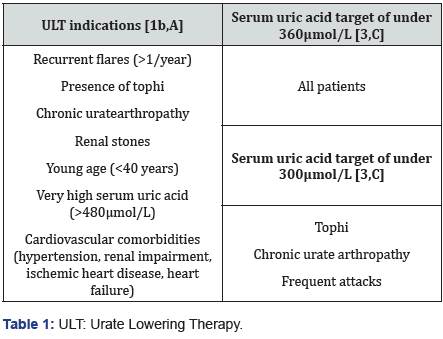Five Things Every Physician should know about the Pharmacologic Management of Gout
Marc-Etienne Parent* and Patrick Liang
Department of Rheumatology, University Centre Intégré de Santé et de Services Sociaux de l’Estrie, Centre Hospitalier Universitaire de Sherbrooke, Canada
Submission: January 24, 2017; Published: February 07, 2016
*Corresponding author: Marc-Etienne Parent, Department of Rheumatology, Centre Intégré de Santé et de Services Sociaux de l’Estrie, Centre Hospitalier Universitaire de Sherbrooke, Canada, Tel: 1-819-346-1110; Email : Marc-Etienne.parent@usherbrooke.ca
How to cite this article: Marc E P, Patrick L. Five Things Every Physician should know about the Pharmacologic Management of Gout. JOJ Case Stud. 2017; 2(1) : 555577.
Abstract
- Urate Lowering Therapy (ULT) is initiated alongside acute attack treatment.
- ULT follows a treat-to-target approach.
- Start low, go slow, but get somewhere.
- ULT should not be interrupted.
- Many drugs influence uricemia.
Keywords: Hyperuricemia; Gout; Urate Lowering Therapy; Pharmacology; Best Practice
Abbreviations: UTL: Urate Lowering Therapy; NSAIDs: Nonsteroidal Anti-Inflammatory Drugs; EULAR: European League Against Rheumatism
Short Communication
1. Urate Lowering Therapy (ULT) is initiated alongside acute attack treatment
Contrary to popular belief, the initiation of ULT during a gout attack does not prolong the attack [1]. However, the initiation/titration of ULT causes uricemia fluctuations, which can precipitate attacks. Thus, prophylaxis with low dose colchicine or non steroidal anti-inflammatory drugs (NSAIDs) should be continued until targeted uricemia is reached and ULT dosage is stable [2].
2. ULT follows a treat-to-target approach
ULT should be progressively increased to reach a specific target. The target, usually 360 or 300μmol/L, is determined by the severity of the disease (see Box 1). Maintaining excessively low uric acid levels (<180μmol/L) is not recommended in the long term [2].
3. Start low, go slow, but get somewhere
Only 5-34% of patients are using >300mg daily of allopurinol with as much as 72% not achieving their targets [3]. The recommended maximum allopurinol dosage, in the absence of severe renal disease [4], is up to 800mg daily. Despite this, if the target is not achieved alternative agents should be sought out, such as febuxostat [2]. Additionally, febuxostat use was recently shown to be secure even in patients with severe chronic kidney disease [5].
4. ULT should not be interrupted
Once the targeted uricemia is reached, a new steady state is created. If ULT is stopped during an attack, the additional uricemia fluctuation will further disturb this steady state, as well as create the need to re-introduce the ULT in the future. It is necessary, however, to re-evaluate the adequacy of ULT and to optimize it as necessary [2].
5. Many drugs influence uricemia
Reviewing the patient’s medication can prove useful. Aspirin, diuretics, and sildenafil can increase uricemia [6], while vitamin C, folic acid, and caffeine can decrease uricemia and the risk of recurrent gout [7]. Certain antihypertensive agents, such as calcium channel blockers and losartan, can aid in further reducing uricemia [2].
Table 1: 2016 European League against Rheumatism (EULAR) Recommendations for the Initiation of ULT and Treatment Targets (Category of evidence, Grade of recommendation) [2] (Table 1).

References
- Eminaga F, Le-Carratt J, Jones A, Abhishek A (2016) Does the initiation of urate-lowering treatment during an acute gout attack prolong the current episode and precipitate recurrent attacks: a systematic literature review. Rheumatol Int 36(12): 1747-1752.
- Richette P, Doherty M, Pascual E, Barskova V, Becce F, et al. (2016) Updated EULAR evidence-based recommendations for the management of gout. Ann Rheum Dis 76(1): 1-14.
- Khanna P, Hagerty D, Mischler R, Morlock R (2013) FRI0397 Adherence to EULAR recommendations for the treatment of GOUT. Ann Rheum Dis 71(Suppl 3): 448-449.
- Dalbeth N, Kumar S, Stamp L, Gow P (2006) Dose adjustment of allopurinol according to creatinine clearance does not provide adequate control of hyperuricemia in patients with gout. J Rheumatol 33(8): 1646-1650.
- Oh Y, Jung SM, Lee S, Park Y, Song JJ (2016) Safety and Efficacy of Febuxostat in Advanced CKD Patients with Hyperuricemia. Arthritis Rheumatol 68(Suppl 10): 9-10.
- Dubchak N, Falasca GF (2010) New and improved strategies for the treatment of gout. Int J Nephrol Renovasc Dis 3: 145-166.
- Singh JA, Reddy SG, Kundukulam J (2011) Risk Factors for Gout and Prevention: A Systematic Review of the Literature. Curr Opin






























